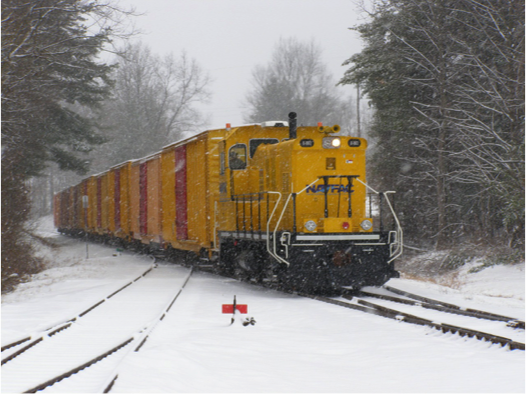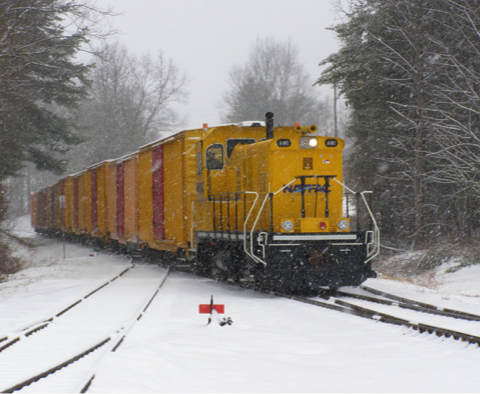 Depending on your climate during the winter months, many modes of transportation—planes, trucks, and ships—become less reliable and safe. This means railways can capitalize on more winter business by being the most reliable transportation method in cold-weather climates.
Depending on your climate during the winter months, many modes of transportation—planes, trucks, and ships—become less reliable and safe. This means railways can capitalize on more winter business by being the most reliable transportation method in cold-weather climates.
Unfortunately, without the proper systems in place, the cold, ice and snow can present problems of their own on the tracks.
Most aspects of a railway can withstand below-freezing temperatures and run as usual. The switch point, however, is vulnerable under cold, wintery conditions.
Like a chain that is only as strong as its weakest link, a defective switch point— responsible for guiding trains from one track to another—can cause delays across the railway.
Read on for the problems switches must overcome in harsh winter climates, potential solutions and which product performs best.
The Job of a Rail Switch Point Heating System
An effective railway switch point heating system addresses these problems common in winter conditions:
- Prevent the moving switch (point) blade from freezing.
- Keep the switch rail from freezing to the supporting slide plates.
- Avoid buildup of snow, sleet or hail between the switch rail and the stock rail that could compact and prevent the point system from operating correctly.
4 Products to Keep the Switch Point Functioning in Cold Weather
To keep rail switch points functional in cold, snowy conditions, engineers have four primary solution options. Some are elementary methods that have been used for decades, while others represent recent technological developments in railway technology. The four types are:
- Anti-Icing Agents: When applied to the switch before a projected snowfall, anti-icing agents activate to melt falling and blowing snow and prevent switches from freezing. While these are effective and safe to use, they must be applied each time snow or ice is anticipated.
- Open Flames: These can be electrical systems installed at switch points and operated remotely, or elementary systems that involve pouring natural gas or oil across the tracks and lighting it manually. While effective against snow and ice, safety is a clear concern when open flames are present on the railway.
- Smudge Pots: As simple as it sounds, a smudge pot is an oil-burning device placed at the switch point to melt nearby snow and ice. Smudge pots were first designed in 1913, so technological advances have created safer, more consistent and more effective alternatives.
- Switch Point Heating System: As the name suggests, these heating systems are placed at each switch point and activate either automatically or manually when needed to heat tracks evenly and prevent snow or ice buildup. Switch point heating systems require higher upfront costs, but after installation they are reliable and require little to no maintenance for years.
With four unique options, specifiers must take into account the performance, cost and long term overall value of the system.
Features of the ERICO Rail Switch Heating System
While each potential solution poses advantages, the reliably keep tracks functional without excess labor or cost. Below are three key advantages of this system.
Self-Regulating Heating Technology
Self-regulating technology allows itself to automatically adjust the power output to compensate for temperature changes. This technology subsequently provides energy cost savings, as it will only run at the power output required of the situation—not above that. It also eliminates the need to monitor individual track conditions and visit the site in person.
Evenly Distributed Heat
Unlike most alternatives that cause uneven heating, infrared tests prove that the temperature across the heating system remains consistent when in use. No hot spots appear across the rail, helping both efficiency and effectiveness.
Low-Maintenance System
Unlike hot air blowers, this system maintains the structural integrity of ballasted track, and can work around obstructions on the rail. Additionally, it is customized to each track, corrosion resistant and easy to repair.
ERICO switch heating technology has been used for more than 20 years on high-speed tracks, passenger and freight trains, metros, tramways and light rapid transit systems.
Want to Learn More About ERICO’s Line of Progressive Railway Solutions?
Our solutions are backed by more than 100 years in the rail market. Download the free Rail Solutions Guide to discover more benefits of the Rail Switch Heating Systems and our other products and solutions.

